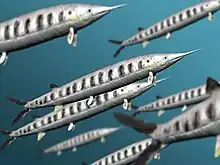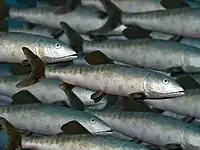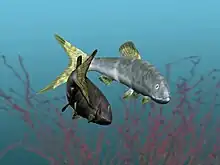| Orthogonikleithrus Temporal range: Late Jurassic, | |
|---|---|
 | |
| Fossil of Orthogonikleithrus hoelli on display at the Jura Museum, Eichstätt, Germany. | |
| Scientific classification | |
| Domain: | Eukaryota |
| Kingdom: | Animalia |
| Phylum: | Chordata |
| Class: | Actinopterygii |
| Order: | Salmoniformes |
| Family: | †Orthogonikleithridae |
| Genus: | †Orthogonikleithrus Arratia, 1987 |
| Type species | |
| †Orthogonikleithrus leichi Arratia, 1987 | |
| Other species | |
| |
Orthogonikleithrus is a genus of extinct ray-finned fish that lived during the Late Jurassic period. It lived in lagoonal and restricted shallow subtidal zones.
Discovery and naming

The type specimen Orthogonikleithrus leichi was described by G. Arratia in 1987, placing it into the Orthogonikleithridae family.[1]
Another species, Orthogonikleithrus francogalliensis was described and assigned to this genus in 2016. It was discovered in Cerin (Ain, France). These specimens were collected during excavations in Cerin by the Université Claude Bernard, Lyon. The fish were not immediately identified as new taxa, and were only assigned during a study on the temporal and spatial distribution of orthogonikleithrid fishes. The new species is superficially similar to Orthogonikleithrus hoelli but differs in several anatomical features, such as the presence of teeth, the number of tubules in the cephalic lateral line system, and the number of hypurals and uroneurals. Due to the record of the genus Orthogonikleithrus in Cerin, the known spatial distribution of this genus was extended, as it formerly was only known from remains in Zandt and Ettling, both in Bavaria, Germany.[2]
References
- ↑ Arratia G. 1987. Anaethalion and similar teleosts (Actinopterygii, Pisces) from the Late Jurassic (Tithonian) of southern Germany and their relationships. Palaeontographica, A 200: 1–44.
- ↑ Konwert, Martin (24 Feb 2016). "Orthogonikleithrus francogalliensis, sp. nov. (Teleostei, Orthogonikleithridae) from the Late Jurassic Plattenkalks of Cerin (France)". Journal of Vertebrate Paleontology. 36 (3): e1101377. doi:10.1080/02724634.2016.1101377. S2CID 88135367.






